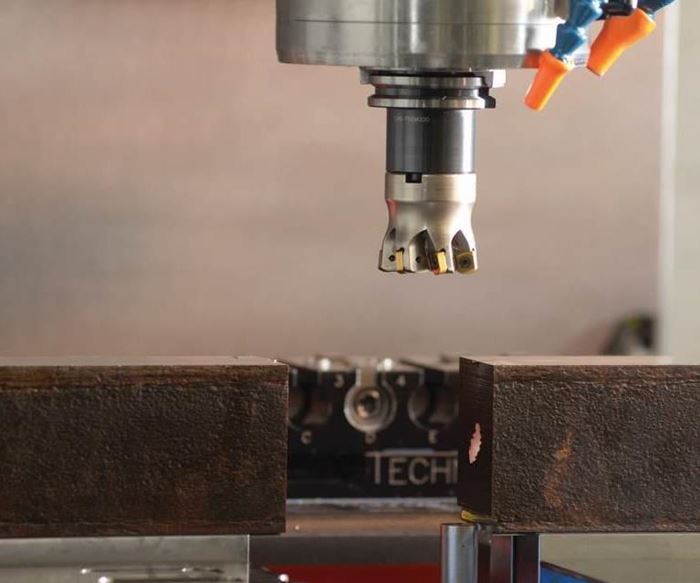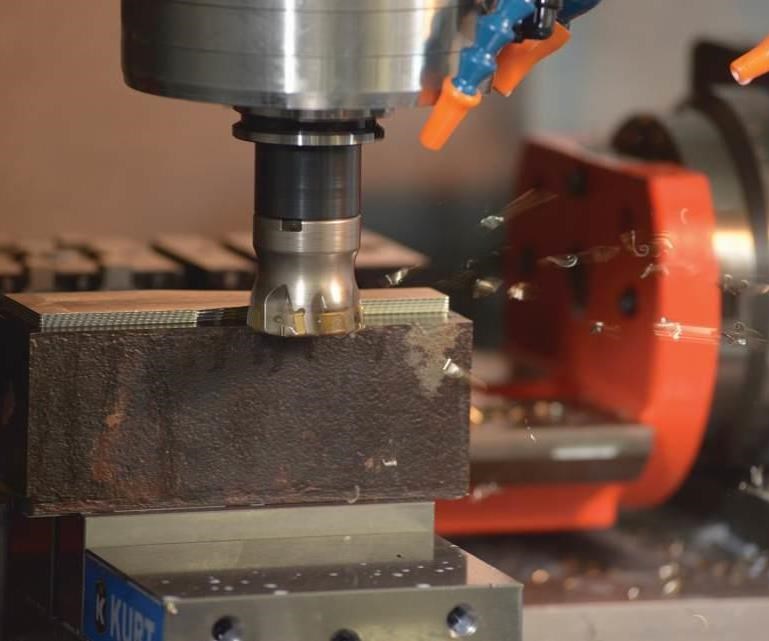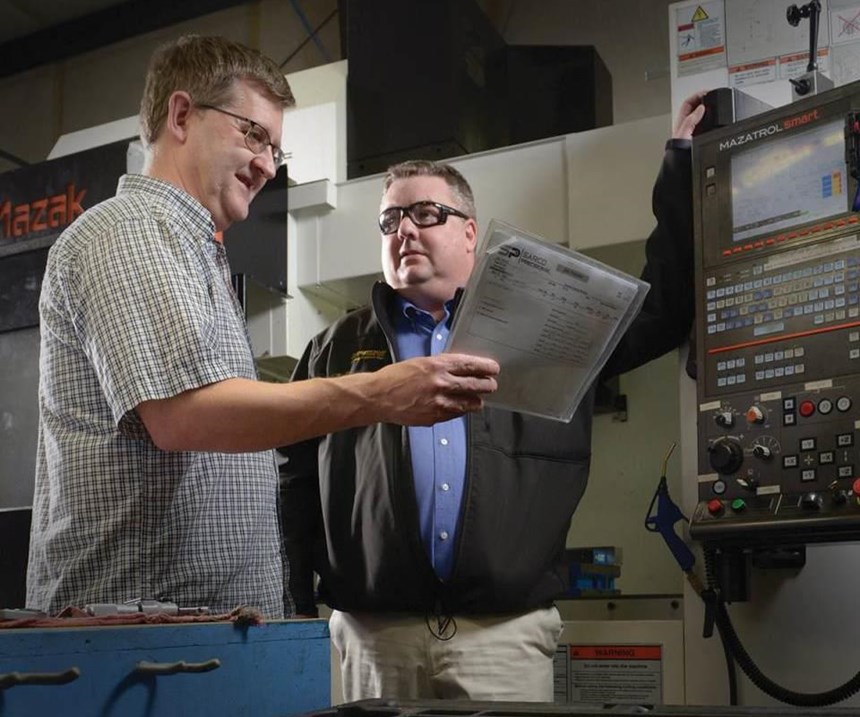Retooling for More Effective Hard Milling
For Sarco Precision, Ingersoll's Hi-Feed Midi cutters solved problems with chatter and frequent tool breakage when milling hard materials on a 40-taper machine.
Share







Hwacheon Machinery America, Inc.
Featured Content
View MoreChanging cutters for a challenging job not only solved a problem for a West Coast shop, but it also enabled the company to establish a new machining niche.
Over the years, Sarco Precision, a 15-person job shop in Mount Vernon, Washington, has earned a comfortable position in the area as a mainstream contract machining business. The company had a solid workforce of employees having an average of 15 to 20 years of machining experience, and a good stable of light- and medium-duty machine tools running 16 hours a day, five days per week. Sarco did a good bit of business in the medical device industry, which puts a premium on light, precision machining. Paul Kline, company president, who bought into the business in 2008, says the operation was comfortable but also very price-competitive.
That said, the shop recently jumped at the chance to bid on a hard-part machining job that offered the potential for steady, repeating work. The part is a heavy actuator link made from 15-5 stainless steel with hardness ranging from 39 to 42 HRC. Measuring only 7.6 by 2.5 by 3.415 inches and having a clevis on one end, the part seemed manageably small and a good candidate for getting Sarco’s feet wet in the growing hard-milling segment of the market. On the other hand, it also required more material removal than Sarco’s standard work. The finished part, which starts out as a 20-pound billet, ends up weighing only 7 pounds after machining.
Sarco ran the job on a 40-taper vertical CNC machine using a 0.75-inch nominal high-feed end mill. Cutting para-meters yielded a 46-minute cycle time to complete the roughing, which was slower than the shop anticipated when it bid on the job. Whenever it tried to run even a little bit faster, the results were chatter, pounding and catastrophic tool failure. “Even at very low feed rates, the $200 end mills ruptured all too often,” Mr. Kline says.
After the first couple of runs, and despite increasing order volumes, Mr. Kline was beginning to wonder whether offering hard milling was a good strategic fit for Sarco. He noted that there appeared to be a basic mismatch between the requirements for hard milling and the company’s skillset and suite of equipment.
In April 2016, Chris Murray, field engineer for Ingersoll Cutting Tools, heard the machine laboring through the profiling part of this job during one of his weekly Sarco walk-throughs. He suggested the shop try using a 2-inch Ingersoll Hi-Feed Midi cutter. “It takes deeper cuts than conventional high-feed mills of similar size and density, yet often actually reduces cutting forces, especially the lateral forces that cause chatter,” Mr. Murray explains. “The larger diameter tool cuts a wider swath and accommodates more inserts to reduce cutting forces per tooth. All in all, it enables heavier cuts on light-duty machines.”
In trials using this tool for the profiling portion of the job, Mr. Murray and Sarco machinist Robert Moore started using the previous parameters and noted how quietly the operation ran despite the hardness of the material. They gradually increased the parameters to 924 sfm, 116 ipm and 0.055-inch depth of cut. Even while achieving double the material removal rate (MRR) as before, the operation ran quietly with no vibration or chatter marks left on the parts. In addition, tool life averaged more than 90 minutes in the cut, which is triple the previous life and more than enough to complete two parts between changeouts.
For the clevis slot, which measures 1.190 by 3.0 by 2.15 inches, Sarco used a 1-inch version of the same Hi-Feed Midi cutter. At first, the original slotting parameters were used, but per Mr. Murray’s guidance, the feed rates and depth of cut were increased, and the new parameters were 1,680 rpm, 101 ipm and 0.030-inch depth of cut. This was approximately 50 percent faster than before, yet the operation ran quietly and free of sudden tool breakage.
Mr. Murray says several features of the Hi-Feed Midi account for Sarco’s improved results. “First, the tool has true radius-style, high-feed geometry and thick inserts that are able to handle depths up to 0.060 inch,” he explains. “That’s why the cutting edges stand up to such high feed rates in hardened stock.” Also contributing is a rigid clamping design with high-tensile clamping screws and a cutting action that orients the main cutting forces axially rather than laterally to reduce the chance for chatter.
After three months of operating at the new parameters and completing approximately 90 parts, the stable process has not had any catastrophic tool failures. In fact, the inserts wear so gradually that the main indicator for tool changeout is deterioration of part surface finish.
Mr. Kline plans to refine the fixturing next time to enable still higher MRRs. “From experience so far, we can tell that the machine and tooling can withstand even faster cutting, but the workpiece will need more rigid support, especially for the clevis slot.”
In fact, success on this job has spurred Sarco to seek out more hard-milling work. “With these new tools, we can handle those heavy-duty jobs on our existing medium-duty machines, avoiding any big-ticket capital purchases.”
This retooling example is typical of small shops that don’t have the time or resources to search for the optimum tooling solution, and must rely on advice from knowledgeable vendors. “Whether or not Ingersoll has the best tooling for every application, their application support is exceptional,” Mr. Kline says. “Even though we’re a small shop, Mr. Murray or some other Ingersoll representative is in here at least once a week, helping us with problems we see and spotting those we don’t. The tougher the problem, the more likely we’ll call him.”
Related Content
Briquetting Manufacturer Tools Up for Faster Turnaround Times
To cut out laborious manual processes like hand-grinding, this briquette manufacturer revamped its machining and cutting tool arsenal for faster production.
Read MoreShoulder Milling Cuts Racing Part's Cycle Time By Over 50%
Pairing a shoulder mill with a five-axis machine has cut costs and cycle times for one of TTI Machine’s parts, enabling it to support a niche racing community.
Read MoreHow to Accelerate Robotic Deburring & Automated Material Removal
Pairing automation with air-driven motors that push cutting tool speeds up to 65,000 RPM with no duty cycle can dramatically improve throughput and improve finishing.
Read MoreThe Impact of Cutting Teeth Spacing on Machining Stability
Many cutter designs are available, and variable teeth spacing (or variable pitch) cutters can be used to influence milling stability. Let’s discuss why teeth spacing affects stability.
Read MoreRead Next
5 Rules of Thumb for Buying CNC Machine Tools
Use these tips to carefully plan your machine tool purchases and to avoid regretting your decision later.
Read MoreRegistration Now Open for the Precision Machining Technology Show (PMTS) 2025
The precision machining industry’s premier event returns to Cleveland, OH, April 1-3.
Read MoreBuilding Out a Foundation for Student Machinists
Autodesk and Haas have teamed up to produce an introductory course for students that covers the basics of CAD, CAM and CNC while providing them with a portfolio part.
Read More





































.png;maxWidth=300;quality=90)
















